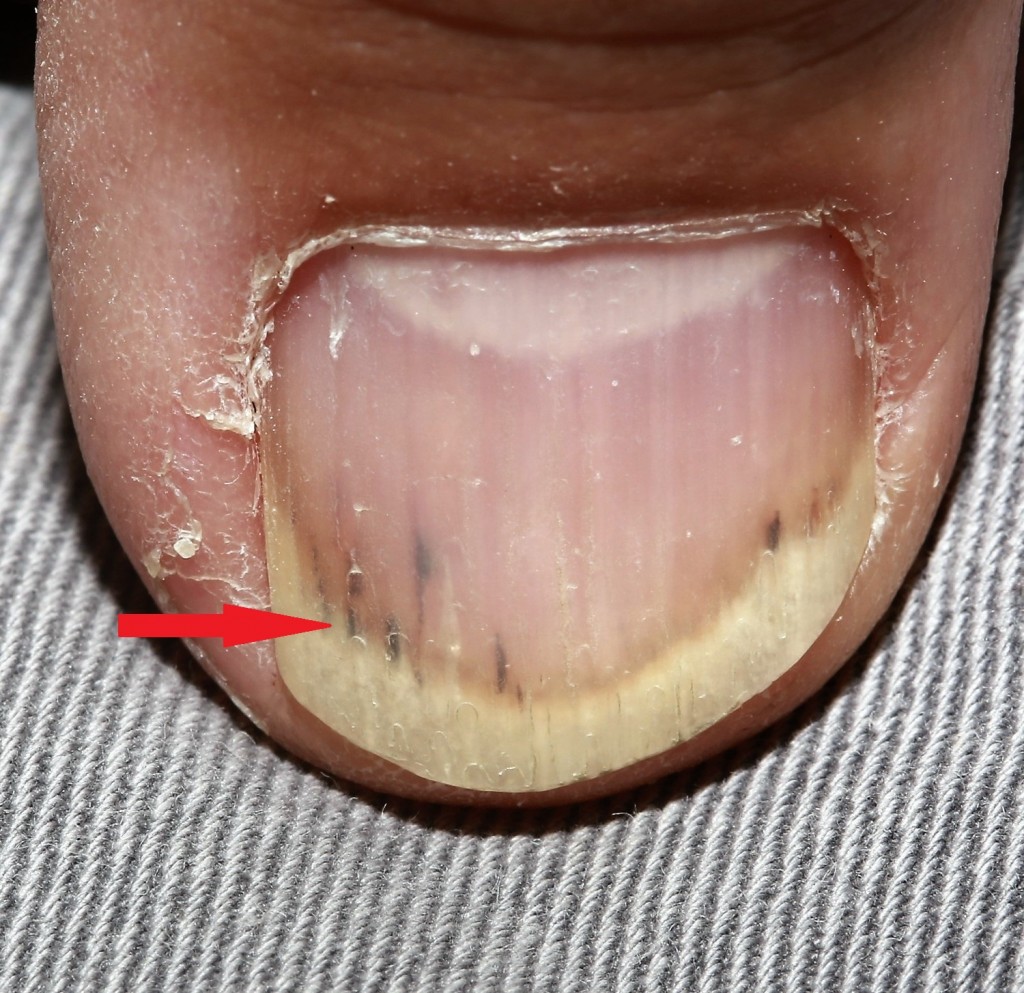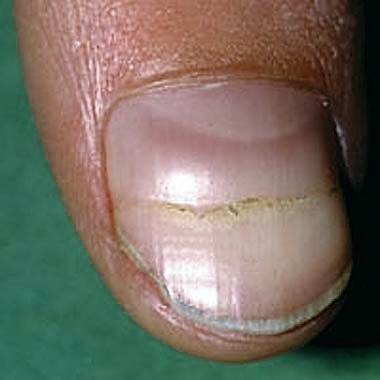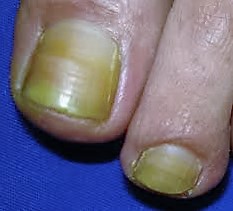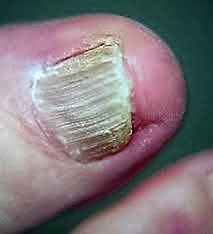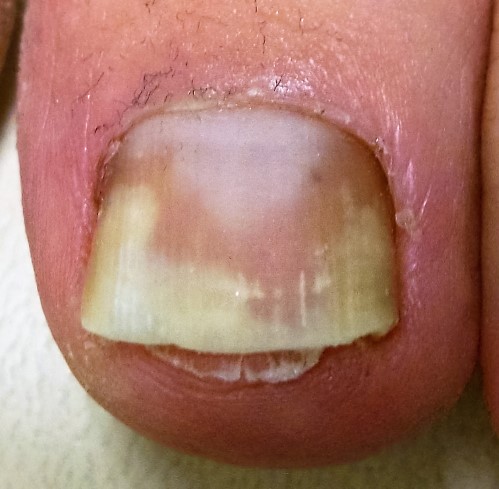Nailing the Diagnosis – Eastern Foot Care Podiatrist Sarah Bowling discusses what your nails say about you
Nailing the Diagnosis
NAIL FACT– in healthy populations fingernails grow at about 0.1mm/day and toenails at about 0.05mm/day-
The appearance of your toenails can tell a Podiatrist or Physician quite a lot about your overall general health. Some systemic conditions can manifest in the toenails with tell-tale signs and symptoms.
Eastern Foot Care Dance and Sports Podiatrist Sarah Bowling has prepared a summary below on some of the obvious and not so obvious nail presentations that Podiatrists look out for.
CLUBBING NAIL
Seen as bulbous, swelling of the soft tissue in the tips of the toes and fingers. The nail may feel springy instead of firm and will have a convexity of the nail fold; generally not associated with any pain. The nail often looks like the back of a spoon.

Clubbing nail may present symmetrically, only on a single nail, unilaterally, bilaterally, just on the hands or just on the feet. The early signs will be a change in the angle of the nail between the nail and the nail bed.
Medically, clubbing nail can be idiopathic (unknown cause) or part of a wide range of diseases, including Pulmonary and Cardiovascular diseases. In diagnosis a full medical history looking at lung, heart and gastro intestinal function will be undertaken. Naturally your Podiatrist will liaise with your treating Physician/Doctor regarding these investigations, should they be required. Long term, the appearance of the nail is potentially reversible if the underlying condition is treated effectively.
KOILONYCHIA or spoon nails
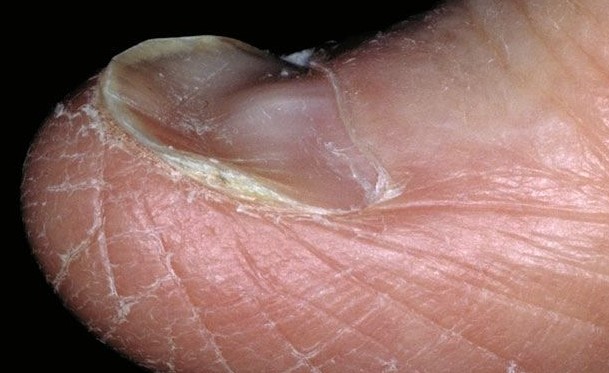 Seen in people with Iron deficiencies, anaemia and autoimmune diseases. In rare cases Koilonychia can also indicate Malnutrition, gastrointestinal bleeding, genitourinary bleeding, worms, malignancy, celiac disease and Plummer-Vinson syndrome. Occasionally infants will have this presentation of the nails however it usually resolves within the first few years of life. It can also be hereditary. Presentation on a single digit will most likely be due to trauma of that nail rather than Koilonychia.
Seen in people with Iron deficiencies, anaemia and autoimmune diseases. In rare cases Koilonychia can also indicate Malnutrition, gastrointestinal bleeding, genitourinary bleeding, worms, malignancy, celiac disease and Plummer-Vinson syndrome. Occasionally infants will have this presentation of the nails however it usually resolves within the first few years of life. It can also be hereditary. Presentation on a single digit will most likely be due to trauma of that nail rather than Koilonychia.
The nails will become abnormally thin and have lost their convexity. The nail plate becomes flat or has a longitudinal concave depression shape. (The opposite appearance of clubbing nail as above).
The nails will be very brittle, chip and break easily. In diagnosis sometimes a water droplet will be placed in the depression and with the curved shape of the nail the droplet will stay in place.
SPLINTER HEMORRHAGE
These are tiny red or brownish blood clots that tend to run vertically on the nail bed in the direction of the nail growth. The nail plate is not affected. They look like a splinter under the fingernail and most often appear in late stage Endocarditis (inflammation of the endocardium). The splinters arise from damage to the capillaries underneath the nail and the reddish brown colour is attributed to the blood that has leaked from the vasculature. In most cases, other symptoms such as shortness of breath, fever or a general feeling of unwell will lead you to a specialist for diagnosis before the splinter hemorrhages even appear. If there hasn’t been any recent injury to the nail and you notice splinter haemorrhages it would be best to seek medical advice.
BEAUS LINES
Are characterised as deep grooved lines that run horizontally across the nail in fingers, and with toenails as indentations or ridges in nail plate. These occur from temporary cessation of cell division in the nail matrix anywhere from 1 day or longer. When the body starts producing the cells again the nail starts to grow out which leaves the Beau’s line.
Beau’s lines are often seen after a high fever, infection, chemotherapy treatment, malnutrition, systemic diseases and illnesses that affect the whole body rather than just one organ. Beginning in the nail fold in the nail fold the timing of the disease can be estimated by measuring the distance from the Beau’s line to the nail bed
Lines will appear on all nails rather than single nail which is more likely to indicate trauma internally or externally to the nail.
PSORIATIC NAILS
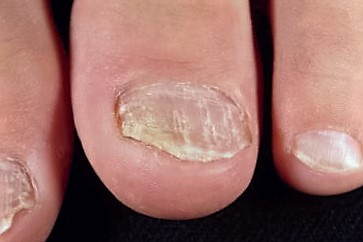 About 1 in 50 people will suffer with psoriasis in their lifetime. Nail changes occur in about half of these people. Psoriatic nails can affect any age or any race and 1 or multiple nails. Severity will also vary over time.
About 1 in 50 people will suffer with psoriasis in their lifetime. Nail changes occur in about half of these people. Psoriatic nails can affect any age or any race and 1 or multiple nails. Severity will also vary over time.
Psoriasis arises within the nail matrix and gives the nail a pitting appearance with areas of white within the nail, separation from the nail bed or scaling underneath the nail.
Transverse lines and ridges, crumbly nail, splinter haemorrhages may also be seen and the nail can become painful and tender. This appearance of the nail can cause psychological distress. Secondary bacterial infections such as paronychia can arise. A sample or biopsy of the nails will confirm the diagnosis.
Psoriatic nails may resolve spontaneously or as a result of systemic treatment or can be present long term.
SUBUNGAL MELANOMA
 Melanoma is a form of cancer or tumour that begins in the skin cells. The appearance underneath the nail can be a dark brown/ purple spot or line present in the absence of trauma. Initially, it could be mistaken for a bruise (haematoma) underneath the nail however over time a melanoma will increase in size and width and if left untreated will become a lesion underneath the nail and lift the nail from the nail bed.
Melanoma is a form of cancer or tumour that begins in the skin cells. The appearance underneath the nail can be a dark brown/ purple spot or line present in the absence of trauma. Initially, it could be mistaken for a bruise (haematoma) underneath the nail however over time a melanoma will increase in size and width and if left untreated will become a lesion underneath the nail and lift the nail from the nail bed.
The feet are often neglected of sunscreen and rarely concealed in the summertime leaving them exposed to harmful UV rays so it is important to inspect the nails every 1-3 months (and without nail polish for most women) to observe any changes.
A biopsy is the first line of treatment.
LEUKONYCHIA
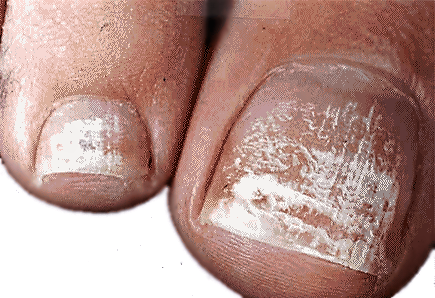 Appears as horozontal white streaks in the nail plate as a result of abnormal keratinisation of the nail. These white dots can easily be caused from trauma but may also be a sign of a systemic illness.
Appears as horozontal white streaks in the nail plate as a result of abnormal keratinisation of the nail. These white dots can easily be caused from trauma but may also be a sign of a systemic illness.
There are several types and categories of Leukonychia from idiopathic, total nail, partial nail, pseudo, striata transversalis and true Leukonychia and these types can often be mistaken for Onychomycosis or fungal nails. It is a good idea to get a nail sample taken by the General Practitioner or Podiatrist for confirmation.
In some cases the white dots will be nothing to worry about and may resolve spontaneously however in some cases there are systemic illnesses that cause the leukonychia and will need treatment, including:
– typhoid fever, leprosy, cirrhosis, trichinosis, cytotoxic drugs, Addison disease or Lupus just to name a few.
YELLOW NAILS
Yellow nails can be caused by a number of conditions, including trauma to the nail, fungal infection of the nail, or a separate condition known as “Yellow Nail Syndrome”
Yellow nail syndrome is seen in patients with serious lymphoedema and pulmonary disease. All nails will be affected and appear stained.
ONYCHORRHEXIS
One of the most common concerns people present with is onychorrhexis of the nail plate, characterised by a brittle/thinning nail plate. This can simply be a symptom of advanced age, or alternatively can be caused by poor nail plate perfusion as a result of Raynaud’s disease (a condition where circulation is slightly impaired in response to colder weather).
ONYCHOLYSIS
Onycholysis occurs when the nail plate becomes loosened or separated from the nail. Due to a lack of capillary pigmentation from the now semi-detached nail bed the nail plate will have a white appearance.
Detached nails can be associated with nail plate injury, infection, thyroid disease and psoriasis. The condition is benign however can result in further nail damage if the nail gets caught on socks, bed sheets etc…
ONYCHOMYCOSIS
One of the most common forms of nail discolouration, onychomycosis is caused by dermatophytes (a type of fungi) resulting in a fungal infection of the nail. Nail fungus is very common in humans and whilst it is a benign condition the appearance of discoloured nails can be distressing to people. A variety of treatment options exist that can be discussed with your treating Podiatrist.
MELANONYCHIA
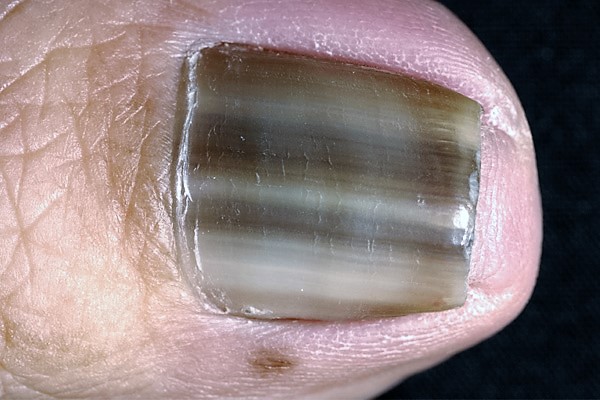 Longitudinal melanonychia is due to increased deposition of skin pigment cells (melanocytes) in a longitudinal pattern down the length of the nail. Whilst anybody can display these dark lines in the nail plate it is more common to individual with darker coloured skin.
Longitudinal melanonychia is due to increased deposition of skin pigment cells (melanocytes) in a longitudinal pattern down the length of the nail. Whilst anybody can display these dark lines in the nail plate it is more common to individual with darker coloured skin.
It is extremely important to have this examined by a Podiatrist to exclude malignant melanoma as a differential diagnosis.
If you or somebody you know are concerned about the appearance of your toenails the expert Podiatrists at Eastern Foot Care Podiatry Ringwood and Eastern Foot Care Podiatry Knox can develop a management strategy to suit your presentation.
To make an appointment contact our friendly staff at:
Eastern Foot Care Ringwood
27 Wantirna Rd, RINGWOOD
Ph: (03) 9870 1301
Eastern Foot Care Knox
5a/426 Burwood Hwy, WANTIRNA SOUTH (Knox)
Ph: (03) 9887 2233
